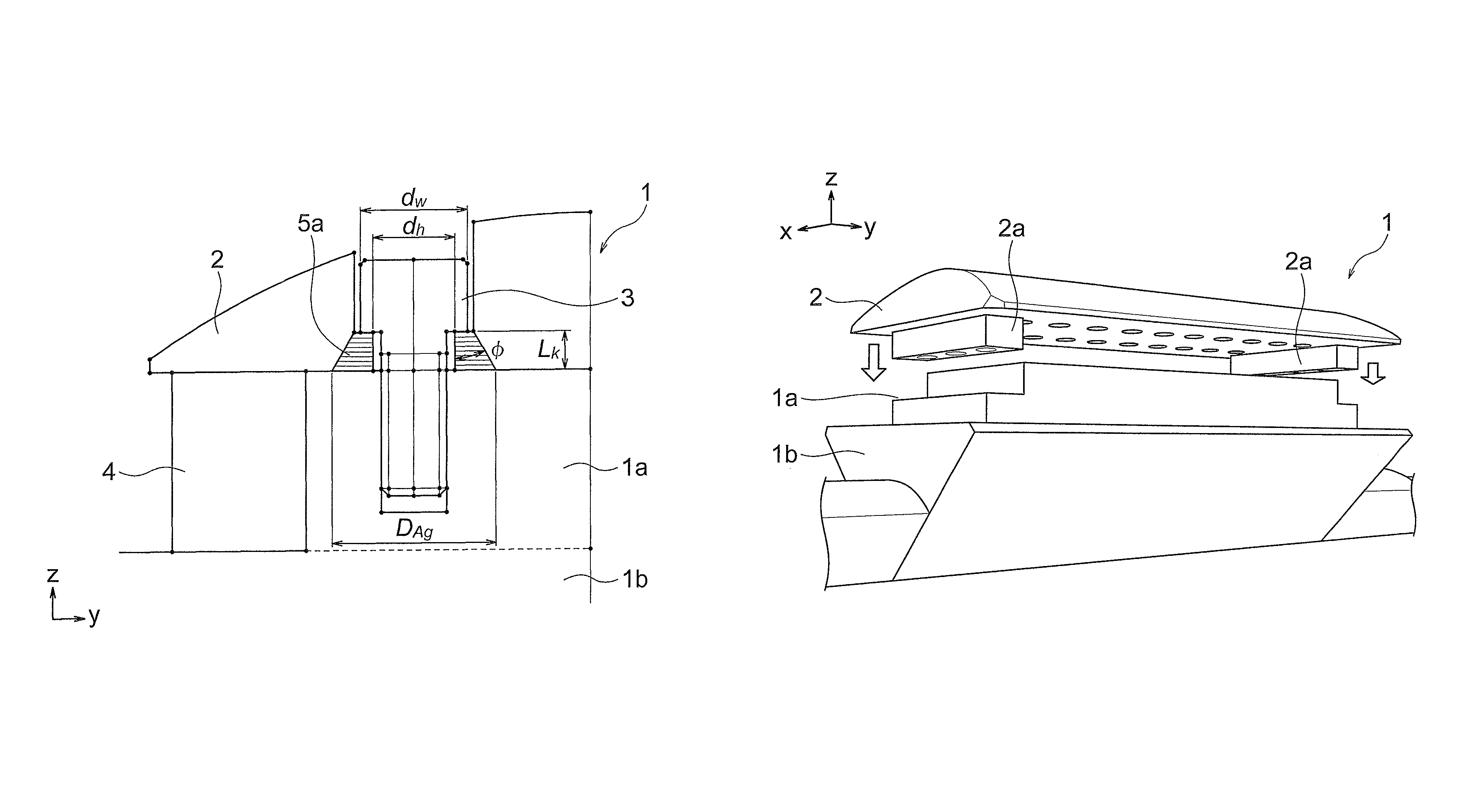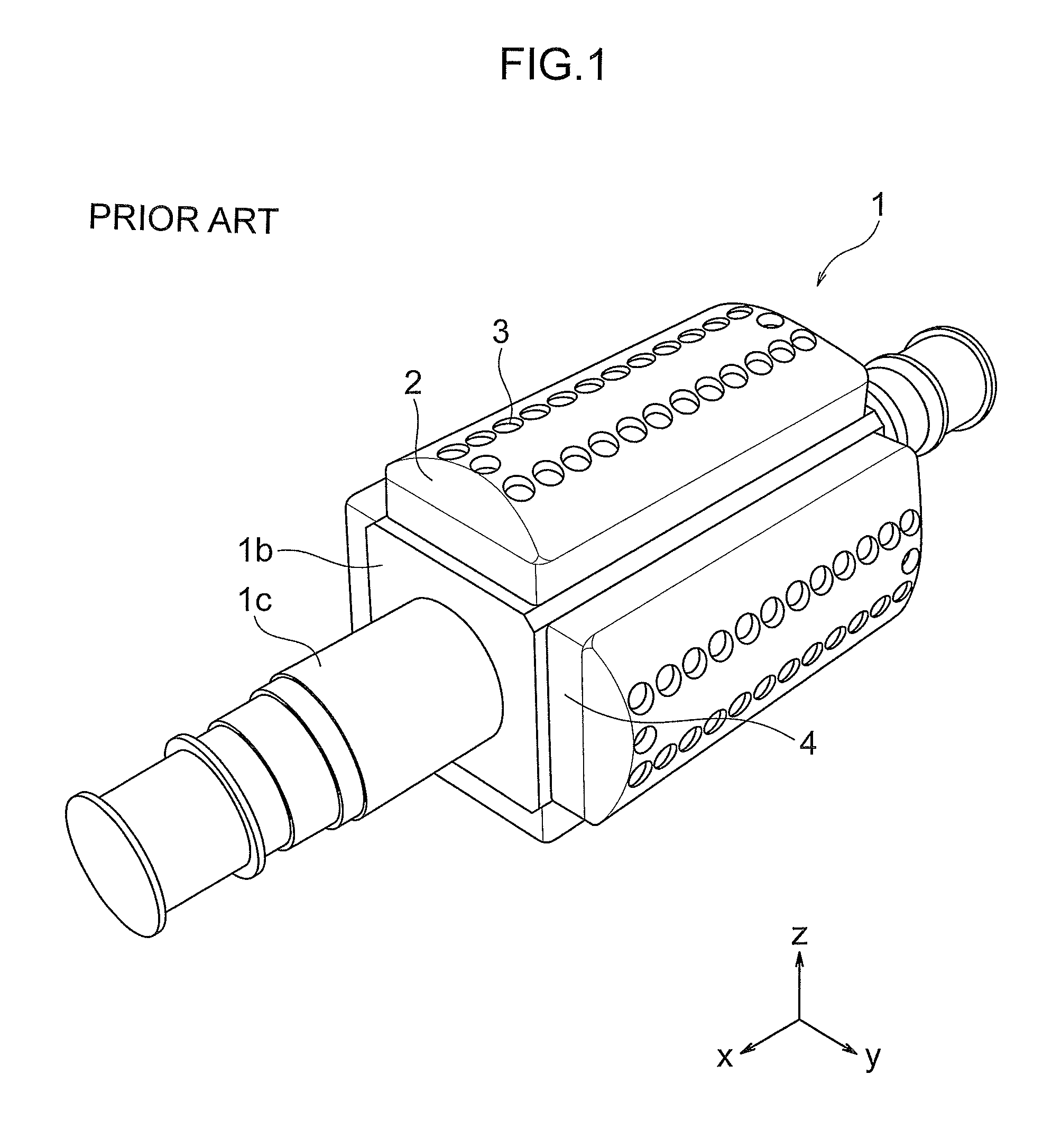Electrical rotating machine
a rotating machine and electric technology, applied in the direction of magnetic circuit rotating parts, magnetic circuit shape/form/construction, etc., can solve the problems of reducing the strength heightening the possibility of the pole shoe b>2/b> breaking, etc., to avoid the fracture of bolts or the breakage of the pole shoe, increase and avoid the effect of increasing the mass of the whole pole sho
- Summary
- Abstract
- Description
- Claims
- Application Information
AI Technical Summary
Benefits of technology
Problems solved by technology
Method used
Image
Examples
example 1
[0060]FIG. 11A is a perspective view of a shaft body 1b, a magnetic field pole body 1a, and a pole shoe 2 in a salient-pole rotor 1 of Example 1. On the other hand, FIG. 11B is a side view of the shaft body 1b, magnetic field pole body 1a and pole shoe 2. As apparent from these figures, the salient-pole rotor 1 of Example 1 is characterized in that only at opposite longitudinal end portions of the pole shoe 2, protrusions 2a are formed extending downward with the same rectangular cross-section relative to a central part of the pole shoe 2 to provide the pole shoe 2 with improved second moment of area. These protrusions 2a can reduce bending stresses on the bolts 3 in the opposite end portions of the pole shoe 2, said bending stresses being to occur due to a deviation of a centrifugal force, and therefore, can prevent breakage of the bolts 3.
[0061]In this example, the pole shoe 2 can be made lighter compared with the conventional configuration. This example can, therefore, reduce an ...
example 2
[0065]FIG. 12A is a perspective view of a magnetic field pole body 1a and a pole shoe 2 in a salient-pole rotor 1 of Example 2. On the other hand, FIG. 12B is a side view of magnetic field pole body 1a and pole shoe 2. The salient-pole rotor of Example 2 is characterized in that different from the salient-pole rotor of Example 1, a wider protrusion 2a extends not only on a lower side of the bolted joint portion b1 but also on a lower side of the bolted joint portion b2, both, on the side of each longitudinal end portion of the pole shoe 2 (see FIGS. 5 and 6).
[0066]It is to be noted that in the present invention, the bolted joint portions included in each row at an area where each protrusion 2a extends are not intended to be limited only to two locations and each protrusion 2a may be arranged from the corresponding longitudinal end portion of the pole shoe 2 to the area where an nth (n: an integer of 1 or greater) bolted joint portion is included. However, the mass of the whole pole ...
example 3
[0067]FIG. 13A is a perspective view of a magnetic field pole body 1a and a pole shoe 2 in a salient-pole rotor 1 of Example 3. On the other hand, FIG. 13B is a side view of magnetic field pole body 1a and pole shoe 2. The salient-pole rotor of this example is characterized in that the height dimensions of protrusions 2a, which extend downward from the pole shoe 2, are lowered stepwise from opposite longitudinal end portions of the pole shoe 2 toward a central part of the pole shoe 2, in other words, as the distances from the opposite longitudinal end portions of the pole shoe 2 increase. As described above, the bolted joint portions included in each row at an area where each protrusion 2a extends downward are not intended to be limited only to two locations in this example. Each protrusion 2a may be arranged from the corresponding longitudinal end portion of the pole shoe 2 to the area where an nth (n: an integer of 1 or greater) bolted joint portion is included, and the height dim...
PUM
 Login to View More
Login to View More Abstract
Description
Claims
Application Information
 Login to View More
Login to View More - R&D
- Intellectual Property
- Life Sciences
- Materials
- Tech Scout
- Unparalleled Data Quality
- Higher Quality Content
- 60% Fewer Hallucinations
Browse by: Latest US Patents, China's latest patents, Technical Efficacy Thesaurus, Application Domain, Technology Topic, Popular Technical Reports.
© 2025 PatSnap. All rights reserved.Legal|Privacy policy|Modern Slavery Act Transparency Statement|Sitemap|About US| Contact US: help@patsnap.com



